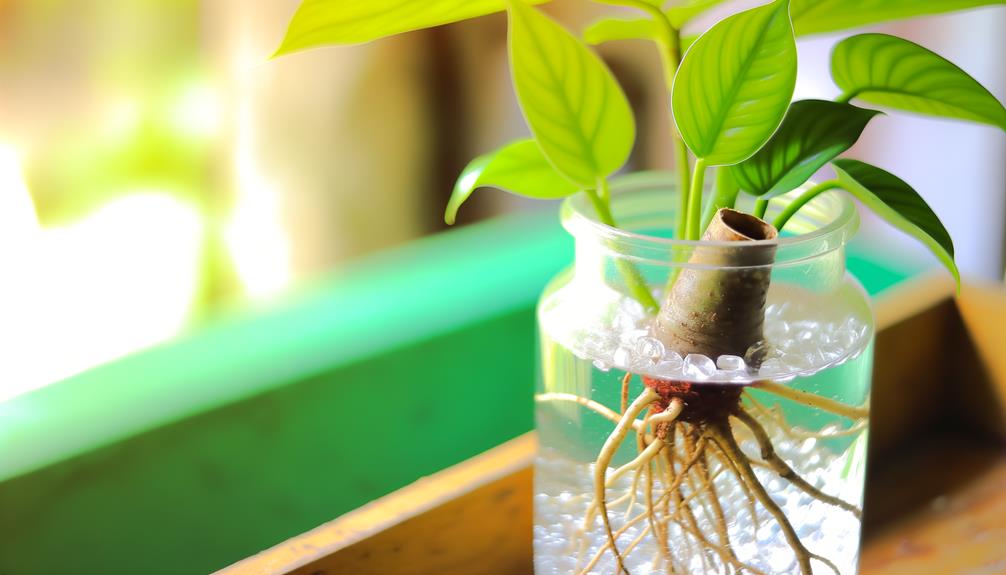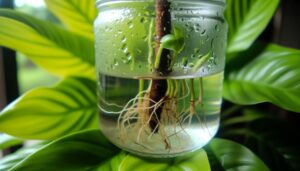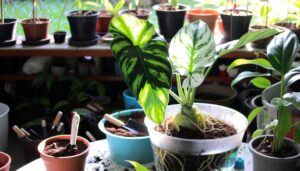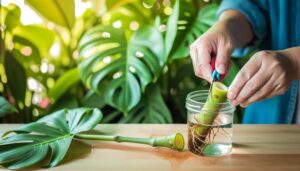Tree Philodendron Propagation in Water
Tree philodendron propagation in water entails several meticulous steps. Begin by selecting healthy cuttings with at least one node, and make a clean cut below the node using a sterilized tool.
Trim the lower leaves and allow the cuttings to callous. Use a clean, see-through glass container filled with chlorine-free water at 65-75°F, maintaining a neutral pH of 6.0-7.0.
Submerge the cut ends and change the water every 5-7 days. Monitor root development and transfer to soil when roots reach 2-3 inches, ensuring consistent moisture and gradual acclimatization.
For further detailed steps, continue exploring.

Key Takeaways
- Select healthy, mature cuttings with at least one node and vibrant leaves.
- Use a sterilized cutting tool and allow cuttings to callous before submerging.
- Choose a clean, see-through glass container deep enough to submerge one node.
- Maintain water temperature at 65-75°F and replace every 5-7 days.
- Transfer to soil once roots reach 2-3 inches and acclimate gradually.
Choosing the Right Cuttings
Selecting the appropriate cuttings is vital for successful tree philodendron propagation in water. Best cuttings should be taken from healthy, mature plants, ensuring strong genetic material.
Choose sections of the stem that include at least one node, the distinct joint where leaves and roots originate. Nodes are important as they contain meristematic tissue capable of developing roots.
The cuttings should be approximately 4-6 inches in length to provide sufficient energy reserves. Avoid cuttings with visible diseases, pests, or damage, as these can hinder root development.
Select specimens with vibrant, green leaves and firm stems. Properly chosen cuttings will enhance the chances of successful root initiation and subsequent growth, ensuring a thriving new plant.
Preparing the Cuttings
To prepare the cuttings for tree philodendron propagation in water, start by sterilizing a sharp cutting tool to prevent the introduction of pathogens. Ensuring a clean tool minimizes the risk of infection, thereby promoting healthy root development.
Next, identify a healthy stem with at least two nodes, as these are essential for root formation. Make a clean cut just below a node, ensuring the section is 4-6 inches long.
Remove any leaves near the base to prevent rot when submerged in water. Finally, allow the cutting to callous over for a few hours to minimize potential decay.
- Sterilize cutting tool
- Select healthy stem with nodes
- Make clean cut below node
- Trim leaves near base
- Allow cuttings to callous
Selecting a Container
A see-through glass jar or vase is ideal for monitoring root development during water propagation of tree philodendrons. The transparency allows for unobstructed observation of emerging roots, maximizing the ability to promptly detect any potential issues.
Select a container with a wide base to provide stability and prevent tipping. The container should be deep enough to submerge at least one node of the cutting, as this is where root initiation occurs. Avoid containers with narrow openings, which may restrict airflow and complicate the removal of the rooted cutting.
Make sure the container is clean and free from residues that could harbor pathogens. By choosing an appropriately sized and shaped container, you facilitate the best conditions for successful root propagation.
Filling With Water
Once a suitable container has been chosen, the next step is to fill it with clean, chlorine-free water to create an ideal environment for root development. Chlorine can be detrimental to root growth, so it is crucial to use dechlorinated water.
Here are some key considerations:
- Water Quality: Use distilled or filtered water to avoid harmful chemicals.
- Water Level: Fill the container to a level that submerges the cut ends but keeps the leaves above water.
- Temperature: Maintain water at room temperature, ideally between 65-75°F (18-24°C).
- Oxygenation: Replenish the water every 5-7 days to ensure sufficient oxygen levels.
- pH Balance: Aim for a neutral pH around 6.0-7.0, as extreme pH levels can hinder root formation.
Placing the Cuttings
When placing the cuttings in water, it is important to select healthy cuttings, typically those with vibrant, unblemished leaves and at least one node.
Ensuring best water conditions involves maintaining a clean, chlorine-free water environment at a stable temperature of around 20-25 degrees Celsius.
This setup promotes root development and reduces the risk of fungal infections and other pathogens.
Choosing Healthy Cuttings
Selecting viable cuttings is vital to successful propagation. It begins with identifying stems that are healthy, pest-free, and contain at least one node for best root development. Look for mature, robust stems with vibrant foliage as indicators of good genetic material.
Guarantee the cutting is approximately 4-6 inches long to provide sufficient length for rooting.
When preparing the cuttings:
- Remove any lower leaves to prevent rotting.
- Use a disinfected cutting tool to prevent infection.
- Choose stems with no signs of disease or damage.
- Ensure each cutting includes at least one aerial root if possible.
- Select stems with firm, green tissue for peak growth potential.
Optimal Water Conditions
Maintaining ideal water conditions is crucial for the successful rooting of Tree Philodendron cuttings. Cuttings should be placed in water that is clean, free from contaminants, and kept at room temperature (20-25°C). The pH level should be slightly acidic to neutral (5.5-7.0) to facilitate nutrient absorption. Regularly replace the water, ideally every 3-5 days, to prevent bacterial growth and oxygen depletion. Additionally, use a transparent container to monitor root development and water clarity.
| Parameter | Optimum Range | Importance |
|---|---|---|
| Temperature | 20-25°C | Promotes enzymatic activities and cellular functions |
| pH Level | 5.5-7.0 | Ensures effective nutrient uptake |
| Water Clarity | Clear, contaminant-free | Prevents bacterial growth and provides visibility |
| Water Change | Every 3-5 days | Maintains freshness and adequate oxygen levels |
Precise adherence to these conditions will improve propagation success.
Monitoring Growth
Regularly monitoring the growth of your tree philodendron cuttings in water is crucial to guarantee healthy root development and overall plant health. Observing the cuttings closely allows for timely interventions and adjustments to ensure best conditions.
Key aspects to monitor include:
- Root Development: Look for white, healthy roots, which indicate successful propagation.
- Water Clarity: Guarantee water remains clear to prevent pathogen buildup.
- Leaf Health: Check for signs of yellowing or decay, suggesting nutrient deficiencies or water issues.
- Stem Stability: Verify that the stem remains firm and upright, indicating robust health.
- Growth Rate: Measure root and shoot length periodically to track progress and make necessary adjustments.
Consistent attention to these factors will foster thriving tree philodendron cuttings.
Transferring to Soil
Moving your tree philodendron from water to soil requires careful preparation to guarantee successful acclimatization. Begin by selecting a well-draining soil mixture, rich in organic matter, to support ideal root development.
Additionally, it is essential to assess the root system's maturity, making sure that roots are adequately developed and strong enough to handle the change without experiencing unnecessary stress.
Preparing the Soil
Before transferring your rooted Tree Philodendron cuttings to soil, it is crucial to prepare a well-draining, nutrient-rich potting mix to promote healthy growth.
The following components are recommended for an excellent potting mix:
- Peat moss: Enhances moisture retention while providing aeration.
- Perlite: Improves drainage and prevents soil compaction.
- Vermiculite: Aids in moisture retention and nutrient exchange.
- Composted organic matter: Supplies essential nutrients and improves soil structure.
- Pine bark: Increases aeration and drainage.
Ensure the potting mix is thoroughly blended to uniform consistency. This balanced composition will support the Tree Philodendron's growth by ensuring adequate moisture retention and proper drainage, preventing waterlogging which can lead to root rot.
This preparation sets the stage for the healthy establishment of the cuttings in their new environment.
Root Development Stages
Once the potting mix is prepared, the next step involves monitoring the root development stages to ensure a successful transfer of the Tree Philodendron cuttings to soil.
Initially, observe the formation of primary roots, which should be white and firm. When roots reach approximately 2-3 inches in length, they are suitable for soil transplantation. At this stage, roots exhibit fine root hairs, enhancing nutrient uptake.
Carefully transfer the cutting into the prepared potting mix, making sure the roots are adequately covered and receive consistent moisture. Gradual acclimatization to soil conditions mitigates transplant shock.
Monitor the cutting for signs of new growth, which indicates successful adaptation. Properly managing each root development stage is essential for robust plant establishment.
Conclusion
The journey of tree philodendron propagation in water, from selecting the ideal cuttings to the meticulous transfer to soil, culminates in a botanical marvel.
As the cuttings adapt to their aqueous environment, roots emerge, signaling the onset of a transformative phase.
Yet, the true test lies ahead: will these nascent roots thrive in soil, ensuring the plant's robust growth?
Only time will reveal the ultimate success of this horticultural endeavor.






